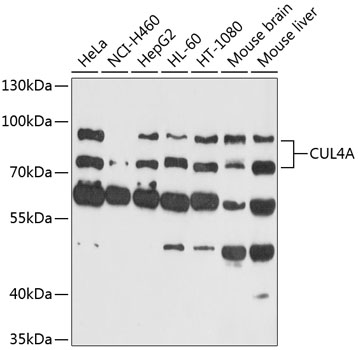Anti-CUL4A Antibody (CAB13911)
- SKU:
- CAB13911
- Product type:
- Antibody
- Reactivity:
- Human
- Reactivity:
- Mouse
- Host Species:
- Rabbit
- Isotype:
- IgG
- Antibody Type:
- Polyclonal Antibody
- Research Area:
- Cell Biology
Description
| 抗体名: | Anti-CUL4A Antibody |
| 抗体コード: | CAB13911 |
| 抗体サイズ: | 20uL, 50uL, 100uL |
| 申し込み: | WB |
| 反応性: | Human, Mouse |
| 宿主種: | Rabbit |
| 免疫原: | Recombinant fusion protein containing a sequence corresponding to amino acids 510-759 of human CUL4A (NP_001008895.1). |
| 申し込み: | WB |
| 推奨希釈: | WB 1:500 - 1:2000 |
| 反応性: | Human, Mouse |
| ポジティブサンプル: | HeLa, NCI-H460, HepG2, HL-60, HT-1080, Mouse brain, Mouse liver |
| 免疫原: | Recombinant fusion protein containing a sequence corresponding to amino acids 510-759 of human CUL4A (NP_001008895.1). |
| 精製方法: | Affinity purification |
| ストレージバッファ: | Store at -20'C. Avoid freeze / thaw cycles. Buffer: PBS with 0.02% sodium azide, 50% glycerol, pH7.3. |
| アイソタイプ: | IgG |
| 順序: | QHMQ NQSD SGPI DLTV NILT MGYW PTYT PMEV HLTP EMIK LQEV FKAF YLGK HSGR KLQW QTTL GHAV LKAE FKEG KKEF QVSL FQTL VLLM FNEG DGFS FEEI KMAT GIED SELR RTLQ SLAC GKAR VLIK SPKG KEVE DGDK FIFN GEFK HKLF RIKI NQIQ MKET VEEQ VSTT ERVF QDRQ YQID AAIV RIMK MRKT LGHN LLVS ELYN QLKF PVKP GDLK KRIE SLID RDYM ERDK DNPN QYHY VA |
| 遺伝子ID: | 8451 |
| Uniprot: | Q13619 |
| セルラーロケーション: | |
| 計算された分子量: | 76kDa/87kDa |
| 観察された分子量: | 80kDa/90kDa |
| 同義語: | CUL4A, cullin-4A |
| バックグラウンド: |
| UniProt Protein Function: | CUL4A: Core component of multiple cullin-RING-based E3 ubiquitin-protein ligase complexes which mediate the ubiquitination and subsequent proteasomal degradation of target proteins. As a scaffold protein may contribute to catalysis through positioning of the substrate and the ubiquitin-conjugating enzyme. The E3 ubiquitin-protein ligase activity of the complex is dependent on the neddylation of the cullin subunit and is inhibited by the association of the deneddylated cullin subunit with TIP120A/CAND1. The functional specificity of the E3 ubiquitin-protein ligase complex depends on the variable substrate recognition component. DCX(DET1-COP1) directs ubiquitination of JUN. DCX(DDB2) directs ubiquitination of XPC. In association with RBX1, DDB1 and DDB2 is required for histone H3 and histone H4 ubiquitination in response to ultraviolet and may be important for subsequent DNA repair. DCX(DTL) plays a role in PCNA-dependent polyubiquitination of CDT1 and MDM2-dependent ubiquitination of TP53 in response to radiation-induced DNA damage and during DNA replication. In association with DDB1 and SKP2 probably is involved in ubiquitination of p27Kip1/p27kip. Is involved in ubiquitination of HOXA9. Component of multiple DCX (DDB1-CUL4-X-box) E3 ubiquitin- protein ligase complexes that seem to consist of DDB1, CUL4A or CUL4B, RBX1 and a variable substrate recognition component which seems to belong to a protein family described as DCAF (Ddb1- and Cul4-associated factor) or CDW (CUL4-DDB1-associated WD40-repeat) proteins. Component of the CSA complex (DCX(ERCC8) complex) containing ERCC8, RBX1, DDB1 and CUL4A; the CSA complex interacts with RNA polymerase II; upon UV irradiation it interacts with the COP9 signalosome and preferentially with the hyperphosphorylated form of RNA polymerase II. Component of the DCX(DET1-COP1) complex with the substrate recognition component DET1 and COP1. Component of the DCX(DDB2) complex with the substrate recognition component DDB2. Component of the DCX(DTL) complex with the putative substrate recognition component DTL. Interacts with DDB1, RBX1, RNF7, CTD1, TIP120A/CAND1, SKP2, p27Kip1, MDM2, TP53 and HOXA9. Interacts with DDB2; the interactions with DDB2 and CAND1 are mutually exclusive. Interacts with VPRBP, DTL, DDA1, DCAF6, DCAF4, DCAF16, DCAF17, DET1, WDTC1, DCAF5, DCAF11, WDR24A, RFWD2, PAFAH1B1, ERCC8, GRWD1, FBXW5, RBBP7, GNB2, WSB1, WSB2, NUP43, PWP1, FBXW8, ATG16L1, KATNB1, RBBP4, RBBP5 and DCAF8. May interact with WDR26, WDR51B, SNRNP40, WDR61, WDR76, WDR5. Can self- associate. Interacts with Epstein-Barr virus BPLF1. Belongs to the cullin family. 2 isoforms of the human protein are produced by alternative splicing. |
| UniProt Protein Details: | Protein type:Ubiquitin conjugating system Chromosomal Location of Human Ortholog: 13q34 Cellular Component: nucleoplasm Molecular Function:protein binding; ubiquitin protein ligase binding Biological Process: cell cycle arrest; DNA damage response, detection of DNA damage; G1/S transition of mitotic cell cycle; negative regulation of cell proliferation; nucleotide-excision repair, DNA damage recognition; nucleotide-excision repair, DNA duplex unwinding; nucleotide-excision repair, DNA incision; nucleotide-excision repair, DNA incision, 3'-to lesion; nucleotide-excision repair, DNA incision, 5'-to lesion; nucleotide-excision repair, preincision complex assembly; nucleotide-excision repair, preincision complex stabilization; protein ubiquitination during ubiquitin-dependent protein catabolic process; response to DNA damage stimulus; transcription-coupled nucleotide-excision repair |
| NCBI Summary: | CUL4A is the ubiquitin ligase component of a multimeric complex involved in the degradation of DNA damage-response proteins (Liu et al., 2009 [PubMed 19481525]).[supplied by OMIM, Oct 2009] |
| UniProt Code: | Q13619 |
| NCBI GenInfo Identifier: | 108936013 |
| NCBI Gene ID: | 8451 |
| NCBI Accession: | Q13619.3 |
| UniProt Secondary Accession: | Q13619,O75834, Q589T6, Q5TC62, Q6UP08, Q9UP17, A2A2W2 |
| UniProt Related Accession: | Q13619 |
| Molecular Weight: | 76,821 Da |
| NCBI Full Name: | Cullin-4A |
| NCBI Synonym Full Names: | cullin 4A |
| NCBI Official Symbol: | CUL4A |
| NCBI Protein Information: | cullin-4A |
| UniProt Protein Name: | Cullin-4A |
| Protein Family: | Cullin |
| UniProt Gene Name: | CUL4A |
| UniProt Entry Name: | CUL4A_HUMAN |


